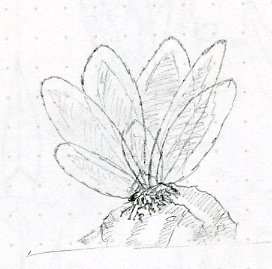

|
Maoun-fau (Sea moss) |
|
Though not a significant staple of Galen diet, Sea moss is an important coastal food source, and has had a long history in Gadarren civilization. The plant itself is rather primitive, sharing many similarities with other halophytic seaweeds. In appearance the plants grow like small tufts of exposed rock, their anchorage is very secure from having to grow against constant battery by the sea, on closer inspection the greenery consists of ellipsoid fronds growing from the holdfast, these fronds are the parts which harvested and eaten. The fronds themselves are diaphanous and subtly green/purple, when wet their texture is slippery but firm when pulled, on drying the fronds become brittle, though retain much of their colour. The fronds are continuously budded from the holdfast, and can rapidly grow to full size within weeks (about 6cm). Sea-moss has not been extensively bred, and is a natural colonizer of most temperate shorelines, however the Galen have cut into rocks, and shoreline to increase the amount area for this particular crop, other methods involve dragging cut boulders off-shore, though the effort of harvesting has prohibited this method to all but the largest coastal communities. The crop is harvested with great ease by using a special type of shears, and by holding the tuft and undercutting with the shears the green fronds can be separated from their holdfast quickly and efficiently, this method is still in use even in these times, as the irregularities of the rock surfaces make this process hard to mechanize (though some larger reserves use robotic harvesters). The crop is taken roughly every 9 weeks, and somewhat less frequently in winter where the climate retards its growth, and much care is taken not to damage the holdfasts, as the fronds regenerate from these. Also by staggering the harvest times small areas of rock can be harvested daily, which provide for fresh material everyday, which is much preferred over the dried form.
Because the sea moss extracts
all of its nutrients from the sea waters areas have been in constant
cultivation for millennia, and although each plant may only last a few
years (ailing plants are ripped out, and are soon replaced by new
colonizing plants, or can be artificially attached) these beds have been
in continuous service. The fresh crop can be eaten raw, though washed
with clean water to remove much of the salt, similarly it can also be
cooked (the coloration is well maintained even after thorough boiling),
and used in a variety of dishes. The more common form encountered in
past times in colonies far from the sea, was the dried form, which is
usually powdered to form a purple/brown flour, this can be reconstituted
with water but is much altered by the drying process (even perfectly
dried specimens will return to loose pulp when mixed with water). In all
colonies it is prized for its nutritive qualities, as it concentrates
rare elements found in sea water (iodine and bromine particularly), the
raw form is also rich in antioxidants, though much of these disappear on
drying. Sea moss and other seaweeds are also still used in traditional
Galen medicine, though extracts of these seaweeds have been found to
have powerful therapeutic effects in modern medicine, especially, Cuulin,
which administered in the correct dosage has a remarkable effect in
boosting immunity by mimicking certain intracellular messengers.
Unfortunately this effect is restricted only to the Galen, though Humans
believe it is an aphrodisiac (scientifically unsupported). |











